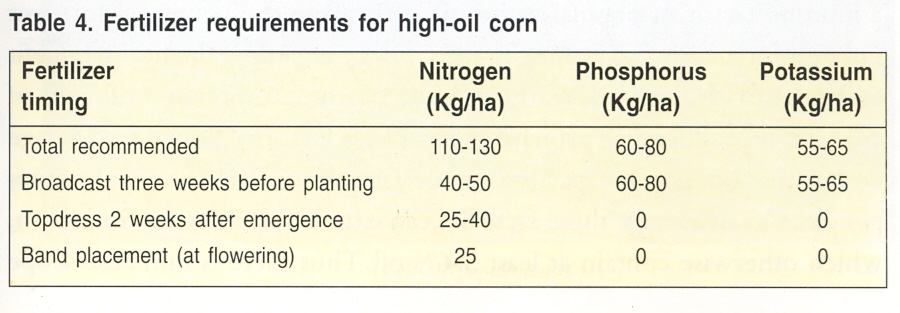Production Technology : Highoil CORN
Production technology of high-oil corn IS not different from normal corn. However, taking the advantage of xenia
effect, oil content in normal hybrids may be enhanced by adopting top cross method of producing high-oil corn.
This method involves blending two types of materials: pollinators (donor of high-oil trait) and normal commercial
hybrids (recipient). On an average 7-8% of the plants are of the high-oil corn pollinator, while the remaining
92-93% of the plants are adopted, high performing commercial hybrids. Pollen from the pollinator transfers
high-oil trait to the kernels of the detasseled commercial hybrids. Thus the xenia effect is exploited to
induce high-oil trait in adopted commercial hybrids. If tassels of donor and recipient hybrids are distinctly
different (pink and green) then 3-8% seeds of donor may be mixed with the recipient hybrids and planted together.
At the time of flowering, before anthesis recipient hybrids may be detasseled and allowed xenia effect to work.
Otherwise, donor lines are to be sown in separate rows in 1:5 to 1:10 ratio (depending on the pollen produced
by the donor lines) and recipient hybrid lines may be detasselled at appropriate time. Additionally high-oil
donors may also be used in hybrid combinations, in which one parent will be used as high-oil line.
High-oil corn can be grown successfully in kharif, rabi and zaid seasons without any difficulty provided assured
irrigation facility is available.
Land Selection: High-oil corn like normal maize can be successfully grown in most parts of the country from plains
to hilly regions up to an elevation of 2700 meters. It can successfully be grown in well-drained soils with pH of
5.5-7.0. However, it may be grown in all types of soils from sandy to heavy clay. Deep heavy soils are considered
better in view of their better water holding capacity. Saline and alkaline soils should be avoided since the crop
suffers adversely right after germination. It will be desirable to avoid low lying areas and fields with poor
drainage. Wherever necessary, surface drainage should be provided before sowing by making shallow and broad
channels across the slope of the field. Places where high-oil corns are to be grown must have facility for 5-6
irrigations. Moisture stress, particularly, at the time of anthesis adversely affect the yield and quality of
the produce.
Land Preparation: High-oil corn requires thorough disc ploughing followed by land leveling. Thereafter
ridges and furrows are to be laid out with an inter row distance of 60-75 cm. It is recommended to incorporate
FYM @5-6 tonnes/ha during last ploughing.
Date of Sowing: Date of sowing has to be suitably adjusted by making best use of natural precipitation.
In irrigated areas, it is most desirable to complete the sowing 10-15 days before onset of rain. The best
planting time is June-July in kharif (rainy) and September-October in rabi (winter) season. Farmers with limited
irrigation can also undertake early sowing by restricting irrigation to shallow furrows in which seeds are sown.
An early sown crop will require 1-2 irrigation before the regular monsoon sets in. During rabi season, optimum
sowing time is middle of October to first week of November.
Seed Rate: It is preferred to use fresh seeds every year. Recommended plant population for optimum yield is
55000-60000 plants per hectare with row spacing of 60-75 cm and intra row spacing of 15-30 cm. This will require
10-11 Kg seeds per ha.
Seed Treatment: Seed treatment with Imidachloprid 70WS @5g/Kg seed takes care of insect pests up to 30 DAS
and fungicide treatment helps to prevent the attack of damping-off fungi.
Method oj Sowing: Two seeds per hill are dibbled manually or mechani¬cally one third from the top on the side
of the ridge. Sowing on ridges serves the twin purpose of water conservation and protection from water logging in
the initial stages to which high-oil corn is highly susceptible. Planting depth should be 3-4 cm for all. Plants
are thinned to one plant per hill 10-12 days after emergence.
Nutrient Management: Fertilizer must be applied according to soil test results (Table 4). A general
recommendation would be to apply a total of 110-130 Kg of nitrogen, 60-80 Kg of phosphate (P2O5) and 55-65 Kg
potash (K2O5) per ha. For early plantings, when cold conditions are often encountered (16°C), use a "starter"
fertilizer (e.g., 85 Kg of 18-46-0 per ha) for improving seedling vigour, stand establishment and early plant
growth is recommended. Fertilizer should be applied in 1 or 2 bands approximately 7-8 cm to the side and 5-7 cm
below the seed.
Weed Management: A field that does not contain noxious weeds must be selected. Crop rotation is important
for limiting the build up of troublesome weeds. Shallow cultivation should be used in concert with chemicals for
weed control. The crop should remain weed-free during the early stages of plant growth; otherwise, yields might be
substantially reduced. Several herbicides are available for weed control. Efficient weed control is achieved for
30-35 days through a spray of the herbicide Atrazine @ 1 Kg ai/ha 1-2 days after the initial irrigation. If double
cropping is practiced, it must be borne in mind that the crop is sensitive to herbicide carryover, particularly
atrazine or atrazine-containing prod¬ucts. Therefore, selection of herbicides should be made accordingly.
|

